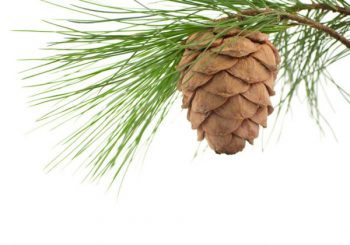Guest Writers for Wake Up World
If you have ever opened a cedar-lined chest containing your family’s treasured keepsakes and mementoes, you’ve probably enjoyed the lovely aroma of cedarwood. It is traditionally used for wooden chests because it resists decay and has natural insect-repellent activity, protecting treasured keepsakes from harm.
But cedarwood has a multitude of other wonderful benefits – inside a single bottle is a world of possibilities!
The aroma of cedarwood can be described as warm and woody, somewhat spicy, a little sweet, and delicious to breathe in. Cedar trees grow in the Atlas Mountains of Morocco, Algeria, and in the Pacific Northwest of America. Cedars are large evergreen trees from the plant family Pinaceae. True cedars exhibit evergreen needles in dense clusters on stout, woody stems. The essential oil is extracted from the wood and bark of the cedar tree by steam distillation.
4 Types of Cedar Trees
There are 4 types of closely-related species considered to be true cedar trees:
- Deodar cedar (Cedrus deodara), from the Himalayan mountains
- Atlas cedar (Cedrus atlantica), from the Atlas Mountains of northwestern Africa
- Lebanese cedar (Cedrus libani), from Lebanon
- Cyprian cedar (Cedrus brevifolia), from Cyprus
You may see “cedarwood” essential oil from a variety of other genera or species on the market. However, it is necessary for the discerning essential oil buyer to pay close attention to the Latin name printed on the label, rather than the more generic term “cedarwood” when purchasing essential oil. Each species will have its own unique aroma, but with regard to phytochemical (an all-natural plant compound) content, several studies have indicated that a similar range is found in all four species of true cedar.
Cedarwood Oil Phytochemical Content
Over 53 different phytochemicals have been isolated in cedarwood oil. To varying degrees, the following plant compounds are present in all four true cedars: alpha-himachalene, beta-himachalene, gamma-himachalene, delta-cadinene, himachalol, germacrene d, cedrol, beta-caryophyllene, alpha-atlantone, beta-atlantone, and gamma-atlantone.
Up to 50% of the phytochemicals in cedarwood oil are sesquiterpenes. Among many other biological functions, sesquiterpenes interact with the limbic system of the brain, helping us handle stress better, lift mood, enhance mental clarity, and encourage feelings of comfort and being grounded.
Interestingly, Cedrus deodara also contains lignans, chemical compounds that form the building blocks of the cell walls of plants. Lignans have been found to have a wide variety of functions in the human body, including immune system support, chemoprotective (protection from cancer) properties, phytoestrogenic (natural plant-based estrogens) benefits, and potent free radical scavenging ability.
Historical Use of Cedarwood Oil
Cedarwood oil has been used for thousands of years. It was one of the oils used by ancient Egyptians in the process of mummification. Ancient healers knew of its benefits for the skin, hair, and other systems of the body long before they understood about germs, antiseptics, and anti-inflammatories.
Cedarwood was known to ease respiratory disorders, to loosen phlegm, and decrease coughing. Cedarwood was observed to have a sedative, calming influence, easing tension and depression. Certain Native American tribes still use cedarwood to enhance communication with the spirit world.
The Research on Cedarwood Essential Oil
Acne, Skin Conditions
Acne plagues many of us at one time or another, and millions of dollars are spent on anti-acne preparations. In 2016, the Journal of Alternative and Complementary Medicine reported a case study indicating cedarwood oil was helpful in controlling acne. While it is true that this was but a single study on one individual, people have been using cedarwood oil for centuries for a variety of skin conditions. Anecdotal evidence tells us cedarwood is helpful for acne, eczema, seborrhoea, and dry skin. It is a natural antiseptic, antioxidant, and anti-inflammatory.
Alopecia areata (hair loss)
Cedarwood has a long tradition of being used for the treatment of hair loss, it seems to stimulate hair follicles and increase circulation to the scalp. Two 2016 Chinese studies found that cedrol, one of the phytochemicals in cedarwood, performed very well for stimulating hair regrowth.
In the first study, mice were shaved and closely monitored for three weeks. In the cedrol-treated group of mice, hair length was remarkably increased, regrowth was heavier, and it outperformed minoxidil (a popular drug developed for combating hair loss).
In the second study, mice were shaved, then either minoxidil or cedrol was applied. They were then treated with cyclophosphamide (a common chemotherapy drug), to induce alopecia. The mice that were pre-treated with cedrol suffered much less hair follicle damage, leading researchers to state “the use of topical cedrol can prevent hair follicle dystrophy and provide local protection against CIA” (chemotherapy-induced alopecia).
An older study performed in 1998 by Scottish researchers reported the results of a randomized trial using certain essential oils for 86 patients with alopecia areata. The active group massaged thyme, rosemary, lavender, and cedarwood in a mixture of carrier oils into their scalps daily. The control group used only carrier oils massaged into their scalps daily. 44% of the patients in the active group showed improvement, compared with only 15% of patients in the control group. Researchers stated
Treatment with these essential oils was significantly more effective than treatment with the carrier oil alone.”
Antibacterial
A 2005 study by Moroccan researchers found cedarwood to have significant antibacterial activity against both gram positive and gram negative bacteria. Another Moroccan study found that even the leaves of Cedrus atlanticus essential oils had potent antibacterial activity.
A 2012 Indian study found that several essential oils, including cedarwood, had potent activity against Streptococcus mutans. This strain of bacteria is commonly found in the human mouth and contributes significantly to tooth decay.
Anti-Cancer
Clinical trials on actual humans utilizing essential oils against cancer are thin on the ground. This is mainly because pharmaceutical companies will not pay for something they cannot patent and clinical trials are expensive. However, it is exciting that there are a growing number of essential oils which demonstrate potent anti-cancer activity in animals and on human cancer cells in test tubes. Hopefully clinical trials on humans will not be far off.
Italian researchers in 2012 investigated cedarwood essential oil against human chronic myeloid leukemia (K562) cells. This was an in vitro (test tube) study wherein cedarwood essential oil was found to have anti-proliferative (slowing or stopping the spread of malignant cells) properties on this cell line.
Another 2012 study reported by Lebanese scientists found that several essential oils, including Cedrus libani, had cytotoxic (cell killing) effects against leukemia cells that were normally resistant to standard drug therapy. Researchers stated “these essential oils might be useful to treat otherwise drug-resistant and refractory tumors.”
A review of research published in 2017 in the journal Natural Product Research by Lebanese and Italian researchers stated “A long-lasting goal of anti-cancer and antimicrobial therapy research is to find compounds with reduced side effects compared to currently approved drugs. In this respect, Cedrus species might be of interest. The essential oil isolated from Cedrus libani leaves may bear potential for drug development due to its high concentrations of germacrene D and [beta]-caryophyllene.”
Indeed, a 2017 Italian study investigated beta-caryophyllene (one of cedarwood’s phytochemicals) in combination with doxorubicin, a much-utilized chemotherapy drug. They found that beta-caryophyllene enhanced the cytotoxicity of doxorubicin, calling it a chemosensitizer (able to re-sensitize chemotherapy-resistant tumor cells).
An older 2007 Canadian study also found that beta-caryophyllene enhanced the effects of a chemotherapy drug, as well as other compounds. Researchers found that beta-caryophyllene significantly increased the anti-cancer activity of paclitaxel, a commonly-utilized chemotherapy drug, against MCF-7, DLD-1, and L-929 cell lines. MCF-7 cells are breast cancer cells, specifically infiltrating ductal carcinoma, exhibiting receptors for both estrogen and progesterone, but negative for HER2 expression. DLD-1 cells are one of four colorectal adenocarcinoma cell lines. L-929 cells are murine (mouse) fibroblast cells. Researchers stated “beta-caryophyllene facilitates the passage of paclitaxel through the membrane and thus potentiates its anticancer activity.”
With regard to the lignans found in Cedrus deodara (mentioned above), a 2006 study performed by Indian researchers found that these lignans had cytotoxic effects on Molt-4 (T-cell acute lymphoblastic leukemia) and HL-60 (acute myeloid leukemia) cancer cells. A 2008 study, also by Indian scientists, investigated the lignans found in Cedrus deodara against four different cancer cell lines. The lignans were found to promote apoptosis (programmed cell death, which is absent in cancer cells) in all four cancer cell lines: Molt-4, HL-60 (both previously described), PC-3 (prostate cancer) and A549 (lung carcinoma).
Antifungal
Cedarwood has a variety of antifungal compounds. In 1997, Indian scientists found in a mouse study that himachalol, one of the phytochemicals in cedarwood, had potent anti-fungal effects. It was tested and found effective against aspergilli, a fungal strain proving to be a huge problem for immunocompromised patients. A later 2012 Indian study found that the sesquiterpenes from Cedrus deodara had antifungal activity against Aspergillus flavus, A. niger, A. ochracoeus, A. parasiticus, and A. sydowii.
Anti-inflammatory
Cedarwood oil has long been observed to have anti-inflammatory effects. A 1999 Indian animal study found it had both analgesic (pain relieving) and anti-inflammatory activity at doses of 50 and 100 mg per kg (2.2 pounds) of body weight.
Antioxidant
The phytochemicals from Cedrus species have been evaluated in a variety of studies which demonstrate their impressive antioxidant activity. A 2013 Romanian study found that Cedrus brevifolia bark extracts exhibited a high degree of radical scavenging ability. In addition, an in vitro study reported in 2014 in Natural Product Communications also found the phytochemicals within the bark of Cedrus brevifolia to have potent antioxidant activity.
Antiviral
An Italian study reported in 2008 found that the phytochemicals within Cedrus libani inhibit the virus HSV-1 (herpes simplex virus 1), which causes painful blisters known as cold sores or fever blisters in humans.
Improves Mental Clarity, Focus
A private study reported by the late Dr. Terry S. Friedmann, a holistic doctor, found that using certain essential oils with children may improve focus and learning capacity. The small study involved 34 children aged six to fourteen diagnosed with Attention Deficit and Hyperactivity Disorder (ADHD). The participants were not on any medications for this condition. They all received EEG (electroencephalogram) and TOVA (test of variables of attention) evaluations at the beginning of the study.
Sixteen of the children received no oils, while 18 children were split into three groups of six children. Each group was given either vetiver, cedarwood, or lavender. Children took three deep inhalations of a particular oil three times per day for 30 days. At the end of the study, the children were again administered EEG and TOVA tests. While vetiver offered the best and most significant improvements, cedarwood also greatly improved focus. In addition, parents reported behavioral improvement and better results on school report cards.
Insect Repellent, Insecticidal
1988 research by Indian scientists found that himachalol and himachalene from cedarwood oil has insecticidal activity against two pests, the pulse beetle and the common fly.
An American study reported in 2014 found that cedarwood oil repelled red imported fire ants. It also repelled and killed black-legged tick nymphs. Researchers stated
These repellency and toxicity results together demonstrate a clear potential for the use of CWO [cedarwood oil] as a pest control agent.”
In 2016 Thai and Austrian researchers found that eight essential oils (including cedarwood) repelled the common mosquito (Culex pipens). They stated that the eight oils (rosemary, eucalyptus globulus, lavender, citronella, tea tree, clove, lemon, patchouli, and cedarwood) outperformed DEET, a commonly used chemical insecticide.
Brazilian research reported in 2016 investigated the effect of seven essential oils on the reproduction of a cattle tick (Rhipicephalus microplus). Researchers found that juniper, palmarosa, cedarwood, lemongrass, ginger, geranium, and bergamot all inhibited tick reproduction in vitro. Palmarosa, lemongrass, and cedarwood showed efficacy higher than 99% at all concentrations tested.
Neuroprotective
Joint research by Mexican, Spanish and Swiss researchers reported in 2017 in the journal Pharmaceuticals (Basel) that beta-caryophyllene exhibited neuroprotective effects. The nerves of mice induced with Parkinson’s Disease were protected in multiple ways by beta-caryophyllene.
Pain Relief
1999 research performed by Indian scientists found that cedarwood oil has analgesic (pain relieving) properties in mice. Brazilian researchers found similar results in a mouse study in 2015. They investigated the effects of cedarwood oil in post-operative mice and found that it “markedly reduced” pain by activating descending pain modulation pathways.
Sedative
Two 2003 Japanese studies, one on rats and mice and one on humans, found that cedrol from cedarwood had marked sedative effects. In the human study, researchers found that cedrol inhalation induced an increase in parasympathetic nervous system activity (involved with resting and digesting) and a reduction in sympathetic nervous system activity (involved in what is often termed the “fight or flight” response).
Precautions for Using Cedarwood
Internal Use: It is not recommended to ingest (take internally) cedarwood oil. It is a strong oil and there have been reports of nausea, vomiting, and other associated problems when taken internally.
Pregnancy: Pregnant women should not use cedarwood essential oil.
Sensitive Skin: Avoid applying cedarwood oil near eyes, ears, or sensitive areas of the body. Those who have sensitive skin should only use cedarwood essential oil when highly diluted (one teaspoonful, or 5 ml, of carrier oil to one to two drops cedarwood). Cedarwood has been known to cause skin irritation in some cases. If unsure, do a patch test prior to applying on a small area of skin just inside the elbow. If a reaction or rash occurs, try a different oil.
Children: Use caution with cedarwood oil for children. Dilute cedarwood for children under age five – one teaspoonful (5 ml) of carrier oil for two drops of cedarwood.
It is not recommended to use any essential oil as a stand-alone treatment for cancer, or for any other health issues mentioned herein. However, when used with other treatments, both conventional and alternative, essential oils can be very helpful.
If you wish to use essential oils for therapeutic purposes, be aware that the quality of essential oils can vary greatly between brands. Do your homework before purchasing essential oils. Find out whether the creator of the oils you wish to purchase uses organic growing methods. Be sure the company knows how to distill the oils properly, without toxic chemicals, so that the essential oil contains the proper complement of phytochemicals.
3 Ways to Use Cedarwood Essential Oil
#1. Deep breathing – Drip 1-2 drops of oil into your hands, place hands over the nose and mouth (avoiding the eyes), and take several deep breaths. Inhaling oils is one of the quickest ways to get essential oils into the bloodstream via the lungs.
#2. Diffusion – Using an ultrasonic cool mist diffuser or essential oil nebulizer, diffuse cedarwood oil into the room. Never heat essential oils because it can ruin their therapeutic potential.
#3. Massage Oil – Dilute cedarwood oil with a good quality, organic carrier oil such as almond, hemp, coconut, or olive. For one tablespoon of carrier oil, use 2-3 drops of cedarwood oil. Massage the oil into affected part of body.
Sources and References:
- [1] Phytochemical and Pharmacological Properties of Essential Oils from Cedrus Species
- [2] Essential Oil Components in Sawdust of Cedrus atlantica from Morocco
- [3] Cedarwood Oil as Complementary Treatment in Refractory Acne
- [4] Hair Growth Promoting Activity of Cedrol Isolated from the Leaves of Platycladus Orientalis
- [5] Preventive Effects of Cedrol Against Alopecia in Cyclophosphamide-treated Mice
- [6] Randomized Trial of Aromatherapy. Successful Treatment for Alopecia Areata
- [7] Antibacterial Diterpenoids from Cedrus Atlantica
- [8] Chemical Composition and In Vitro Antibacterial Activity of the Essential Oil of Cedrus atlantica
- [9] Antimicrobial Activity of Commercially Available Essential Oils Against Streptococcus Mutans
- [10] In Vitro Evaluation of the Anti-proliferative Activities of the Wood Essential Oils of Three Cedrus Species Against K562 Human Chronic Myelogenous Leukaemia Cells
- [11] Phytochemical Analysis and Cytotoxicity Towards Multidrug-resistant Leukemia Cells of Essential Oils Derived from Lebanese Medicinal Plants
- [12] Phytochemical and Pharmacological Properties of Essential Oils from Cedrus Species
- [13] Chemosensitizing Properties of ß-Caryophyllene and ß-Caryophyllene Oxide in Combination with Doxorubicin in Human Cancer Cells
- [14] Potentiating Effect of Beta-caryophyllene on Anticancer Activity of Alpha-humulene, Isocaryophyllene and Paclitaxel
- [15] A Novel Lignan Composition from Cedrus Deodara Induces Apoptosis and Early Nitric Oxide Generation in Human Leukemia Molt-4 and HL-60 Cells
- [16] Induction of Apoptosis by a Synergistic Lignan Composition from Cedrus Deodara in Human Cancer Cells
- [17] Comparative in Vitro and in Vivo Evaluation of Himachalol in Murine Invasive Aspergillosis
- [18] Antifungal Sesquiterpenes from Cedrus Deodara
- [19] Studies on the Anti-inflammatory and Analgesic Activity of Cedrus Deodara (Roxb.) Loud. Wood Oil
- [20] 15-lipoxygenase Inhibition, Superoxide and Hydroxyl Radicals Scavenging Activities of Cedrus Brevifolia Bark Extracts
- [21] In Vitro Antioxidant Activity and Phenolic Content of Cedrus Brevifolia Bark
- [22] Phytochemical Analysis and in Vitro Evaluation of the Biological Activity Against Herpes Simplex Virus Type 1 (HSV-1) of Cedrus Libani A. Rich
- [23] Attention Deficit and Hyperactivity Disorder (ADHD) by Terry S. Friedmann
- [24] Himachalol and ß-himachalene: Insecticidal Principles of Himalayan Cedarwood Oil
- [25] Bioactivity of Cedarwood Oil and Cedrol Against Arthropod Pests
- [26] “Singing in the Tube”– Audiovisual Assay of Plant Oil Repellent Activity Against Mosquitoes (Culex Pipiens)
- [27] In Vitro Effect of Seven Essential Oils on the Reproduction of the Cattle Tick Rhipicephalus Microplus
- [28] Neuroprotective Effects of ß-Caryophyllene against Dopaminergic Neuron Injury in a Murine Model of Parkinson’s Disease Induced by MPTP
- [29] Inhalation of Cedrus atlantica Essential Oil Alleviates Pain Behavior Through Activation of Descending Pain Modulation Pathways in a Mouse Model of Postoperative Pain
- [30] The Sedative Effects and Mechanism of Action of Cedrol Inhalation with Behavioral Pharmacological Evaluation
- [31] Autonomic Responses During Inhalation of Natural Fragrance of Cedrol in Humans
Originally published at The Truth About Cancer and reproduced here with permission.
About the author:
 Ty Bollinger is a health freedom advocate, cancer researcher, former competitive bodybuilder and author. After losing several family members to cancer, he refused to accept the notion that chemotherapy, radiation, and surgery were the most effective treatments available for cancer patients. He began a quest to learn all he possibly could about alternative cancer treatments and the medical industry. What he uncovered was shocking. There is ample evidence to support the allegation that the “war on cancer” is largely a fraud and that multinational pharmaceutical companies are “running the show.” Ty has now made it his life mission to share the most remarkable discovery he made on his quest: the vast majority of all diseases, including cancer, can be easily prevented and even cured without drugs or surgery.
Ty Bollinger is a health freedom advocate, cancer researcher, former competitive bodybuilder and author. After losing several family members to cancer, he refused to accept the notion that chemotherapy, radiation, and surgery were the most effective treatments available for cancer patients. He began a quest to learn all he possibly could about alternative cancer treatments and the medical industry. What he uncovered was shocking. There is ample evidence to support the allegation that the “war on cancer” is largely a fraud and that multinational pharmaceutical companies are “running the show.” Ty has now made it his life mission to share the most remarkable discovery he made on his quest: the vast majority of all diseases, including cancer, can be easily prevented and even cured without drugs or surgery.
For more information, visit:

If you've found value in our articles, we invite you to support the release of our brand-new book, "Gratitude Practices for Kids: A Practical Guide for Adults to Instill a Spirit of Appreciation and Positivity in the Next Generation."
"Gratitude Practices for Kids" brings together over 25 innovative and accessible practices designed to enhance gratitude in everyday life. This comprehensive guide is backed by 17 scientific studies, ensuring each concept is grounded in research, underscoring our commitment to nurturing growth, emotional intelligence, and positive interactions between adults and children.
We encourage you to opt for the paperback version to celebrate this new release. Dive into its fresh pages away from digital distractions, allowing you to immerse yourself in the transformative practices it offers.
Over recent years, Wake Up World has faced significant online censorship, which has impacted our financial ability to operate. Moving into book publishing represents a strategic step to secure the ongoing funds needed to continue our mission. By purchasing Gratitude for Kids, you help us keep our content free and accessible to everyone, avoiding needing a paywall. With over 8,500 articles published in the last 13 years, we remain dedicated to keeping our valuable content open to all.








